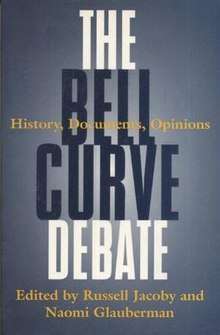The Bell Curve Debate
The Bell Curve Debate is a 1995 book edited by the historian Russell Jacoby and the writer Naomi Glauberman.[1]
 | |
| Editors | Russell Jacoby, Naomi Glauberman |
|---|---|
| Country | United States |
| Language | English |
| Subject | The Bell Curve |
| Publisher | Random House |
Publication date | 1995 |
| Media type | Print (paperback) |
| Pages | 720 |
| ISBN | 0-8129-2587-4 |
| OCLC | 31969295 |
| 305.9/082 20 | |
| LC Class | BF431 .B3748 1995 |
Summary
A response to The Bell Curve (1994), by the psychologist Richard Herrnstein and the political scientist Charles Murray, The Bell Curve Debate includes 81 articles by 81 authors. Contemporary authors whose writings are collected in the book include K. Anthony Appiah, Gregg Easterbrook, Howard Gardner, Eugene D. Genovese, Nathan Glazer, Stephen Jay Gould, Bob Herbert, Richard Herrnstein, Christopher Hitchens, Irving Louis Horowitz, Arthur Jensen, Leon J. Kamin, Charles Lane, Glenn C. Loury, Richard E. Nisbett, Nell Irvin Painter, Hugh Pearson, Adolph Reed Jr., Carl Rowan, Alan Ryan, Brent Staples, Ellen Willis, and Christopher Winship. Jacoby and Glauberman republish historical materials by authors including Carl Brigham, Theodosius Dobzhansky, Francis Galton, Walter Lippmann, Karl Pearson, and Lewis Terman. The publisher, Times Books, describes the book as a compilation of "the best of recent reviews and essays, and salient documents drawn from the curious history of this heated debate" capturing "the fervor, anger, and scope of an almost unprecedented national argument over the very idea of democracy and the possibility of a tolerant, multiracial America. It is an essential companion and answer to The Bell Curve and provides scholarship and polemic from every point of view."
Since publication, The Bell Curve Debate has been cited by books describing the issues surrounding IQ testing and scores of various social groups in the United States.[2][3][4][5][6][7]
References
- Jacoby, Russell; Glauberman, Naomi, eds. (1995). The Bell Curve Debate: History, Documents, Opinions. New York: Times Books. ISBN 0-8129-2587-4. LCCN 95003797. Lay summary (14 August 2015).CS1 maint: ref=harv (link)
- Devlin, Bernie; Fienberg, Stephen E.; Resnick, Daniel P.; Roeder, Kathryn, eds. (1997). Intelligence, Genes, and Success: Scientists Respond to the Bell Curve. New York (NY): Springer. pp. 255, 350–351. ISBN 978-0-387-94986-4. Lay summary (14 August 2015).CS1 maint: ref=harv (link)
- Zenderland, Leila (23 April 2001). Measuring Minds: Henry Herbert Goddard and the Origins of American Intelligence Testing. Cambridge University Press. p. 366. ISBN 978-0-521-00363-6. Retrieved 14 August 2015. Lay summary (14 August 2015).CS1 maint: ref=harv (link)
- Fish, Jefferson M., ed. (2002). Race and Intelligence: Separating Science From Myth. Mahwah (NJ): Laurence Erlbaum Associates. pp. 92, 196–197. ISBN 978-0-8058-3757-5. Retrieved 14 August 2015 – via Questia. Lay summary (30 August 2010).CS1 maint: ref=harv (link)
- Nyborg, Helmuth, ed. (2003). The Scientific Study of General Intelligence: Tribute to Arthur R. Jensen. Amsterdam: Pergamon. pp. 500, 578, 593. ISBN 978-0-08-043793-4. Lay summary (16 May 2013).CS1 maint: ref=harv (link)
- Jackson, John P.; Weidman, Nadine M. (1 January 2004). Race, Racism, and Science: Social Impact and Interaction. ABC-CLIO. pp. 235, 380. ISBN 978-1-85109-448-6. Retrieved 14 August 2015. Lay summary (14 August 2015).CS1 maint: ref=harv (link)
- Hilliard, Constance (30 April 2012). Straightening the Bell Curve: How Stereotypes about Black Masculinity Drive Research on Race and Intelligence. Potomac Books. p. 140. ISBN 978-1-61234-191-0.CS1 maint: ref=harv (link)